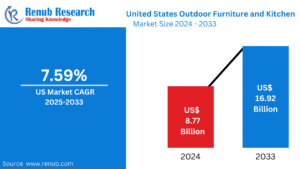United States Cheese Market (2025–2033): Industry Size, Share, Growth Trends, and Forecast with Company Analysis
Press Release:
The United States Cheese Market is projected to grow significantly over the coming years, with the market size expected to rise from US$ 39.51 billion in 2024 to US$ 53.66 billion by 2033, at a CAGR of 3.46% during the forecast period. This growth is largely attributed to increasing consumer demand for premium, organic, and plant-based cheeses, as well as a surge in cheese consumption in fast food, ready-to-eat, and gourmet applications. Leading market players are investing in product innovation, sustainability, and expansion strategies to meet evolving consumer preferences.
Market Overview
Cheese continues to be a staple in American diets, spanning a wide variety of culinary applications—from traditional comfort foods like macaroni and cheese to artisanal charcuterie boards and health-conscious salads. Cheese production in the U.S. includes a range of types such as cheddar, mozzarella, ricotta, parmesan, and cream cheese, with plant-based versions rapidly gaining popularity among environmentally and health-conscious consumers.
Market Size and Forecast
| Metric | Value |
| Market Size (2024) | US$ 39.51 Billion |
| Market Forecast (2033) | US$ 53.66 Billion |
| CAGR (2025–2033) | 3.46% |
Key Growth Drivers
- Rising Demand for Premium and Specialty Cheeses: Consumer interest in gourmet, artisanal, and organic cheese varieties is on the rise.
- Fast Food and Ready-to-Eat Industry Expansion: Cheese is a key ingredient in a variety of fast food and packaged snack offerings.
- Health-Conscious Consumption Trends: Low-fat, reduced-sodium, and plant-based cheese alternatives are seeing rapid growth.
- Plant-Based Innovation: Brands are developing sustainable and non-dairy cheese options to cater to vegan and lactose-intolerant consumers.
Market Challenges
1. Health and Dietary Shifts
Consumers are increasingly aware of the health risks associated with high sodium and saturated fat intake, leading to reduced consumption of traditional dairy cheese. Additionally, the rise in lactose intolerance and veganism is compelling producers to reformulate their offerings.
2. Environmental Concerns
The environmental footprint of dairy farming—including greenhouse gas emissions, water consumption, and land use—is under scrutiny. Companies are under pressure to adopt sustainable practices and transparent sourcing, often at higher operational costs.
Segment Analysis
By Type
- Animal-Based Cheese: Continues to dominate due to traditional use, taste, and established supply chains.
- Plant-Based Cheese: Fastest-growing segment, fueled by innovations in almond, cashew, soy, and oat-based alternatives.
By Product
- Mozzarella: Favored for being lighter in fat and widely used in pizzas and salads. Increasingly offered in low-fat and dairy-free variants.
- Cheddar: Popular in processed foods and snacking; witnessing innovation in sharpness and aging techniques.
- Parmesan: High-value market due to its premium, aged status and culinary versatility.
- Ricotta: Gaining popularity in high-protein diets and health-focused recipes.
- Cream Cheese: Driven by demand in baking and spreads.
- Others: Includes brie, blue cheese, feta, and newer international varieties.
By Distribution Channel
- Hypermarkets/Supermarkets: Dominant channel due to wide selection and physical shopping experience.
- Convenience Stores: Offers grab-and-go options, particularly for sliced and packaged cheese.
- Online Retail: Witnessing fast growth due to increased consumer comfort with e-commerce, including direct-from-farm platforms.
- Others: Includes specialty stores, gourmet retailers, and cheese subscription services.
Noteworthy Market Development
- In April 2024, Lifeway’s Farmer Cheese won the “Best Snack” award by Good Housekeeping, highlighting the rise in demand for healthy, high-protein cheese snacks.
- Major cheese manufacturers are expanding production facilities and focusing on plant-based innovations to address both health and environmental concerns.
Company Analysis
Each profiled company includes an overview, recent developments, and revenue highlights:
1. Land O’Lakes
- Overview: A cooperative with strong roots in dairy, particularly known for its butter and cheese products.
- Recent Development: Expanded its cheese snack segment with high-protein string cheese and cubes.
- Revenue: Multi-billion-dollar annual revenues across dairy segments.
2. Saputo Inc.
- Overview: One of North America’s largest dairy processors.
- Recent Development: Invested in sustainable packaging and reduced-fat cheese R&D.
- Revenue: Strong presence in both U.S. and Canadian markets.
3. Arla Foods amba
- Overview: Danish multinational cooperative known for organic and European-style cheeses.
- Recent Development: Launched plant-based cheese under “Arla Pro” targeting food service.
- Revenue: Leading player in European-style cheeses.
4. The Kraft Heinz Company
- Overview: Market leader in processed cheese categories.
- Recent Development: Rolled out a new vegan cheese line under the Kraft Singles brand.
- Revenue: One of the top revenue generators in U.S. cheese.
5. Royal FrieslandCampina N.V.
- Overview: Dutch dairy giant with growing presence in U.S. specialty cheese.
- Recent Development: Introduced environmentally sustainable gouda and edam varieties.
- Revenue: Emphasis on export-quality and gourmet cheese.
6. Glanbia Plc
- Overview: Focuses on high-protein dairy products.
- Recent Development: Integrated whey-based cheese offerings with fitness and health snacks.
- Revenue: Growing niche in health-oriented dairy products.
7. Savencia Fromage & Dairy
- Overview: French cheese specialist expanding into U.S. gourmet segment.
- Recent Development: Partnered with U.S. retailers for direct-to-consumer distribution.
- Revenue: Strength in premium, imported, and European cheese varieties.
Conclusion
The United States cheese market is poised for steady growth through 2033, with innovation in healthier, plant-based, and gourmet products driving demand. While traditional cheese remains a staple, brands must adapt to changing consumer preferences and environmental expectations. Strategic investments in sustainability, product innovation, and omnichannel retail presence will determine long-term success in this evolving market landscape.
























